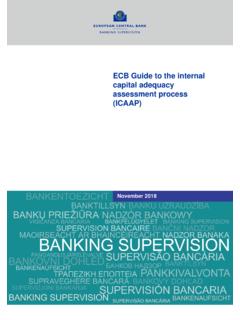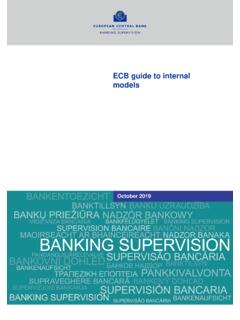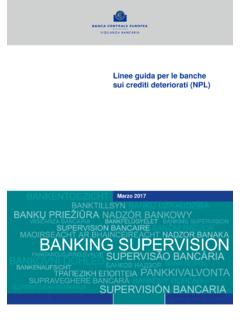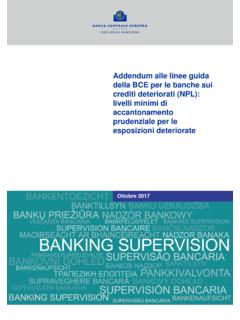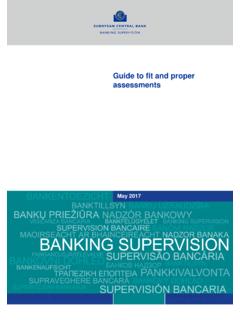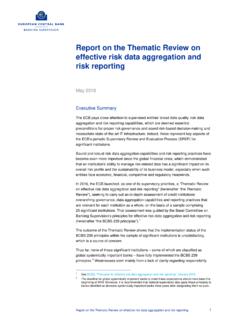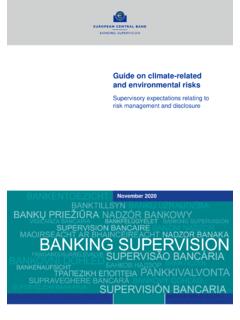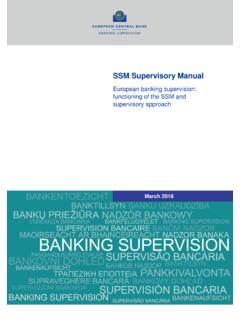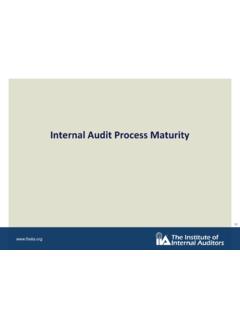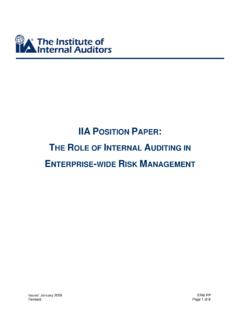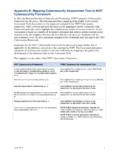Transcription of ECB guide to internal models - Risk-type-specific chapters
1 ECB guide to internal models Risk-type-specific chapters For any future reference, please use the consolidated version. September 2018. Contents Foreword 3. Credit risk 5. 1 Scope of the credit risk chapter 5. 2 Data maintenance for the IRB approach 5. 3 Data requirements 14. 4 Probability of default 20. 5 Loss given default 35. 6 Conversion factors 53. 7 Model-related MoC 61. 8 Review of estimates 62. 9 Calculation of maturity for non-retail exposures 64. Market risk 66. 1 Scope of the market risk chapter 66. 2 Scope of the internal model approach 67. 3 Regulatory back-testing of VaR models 82. 4 Aspects of internal validation of market risk models 93.
2 5 Methodology for VaR and stressed VaR 98. 6 Methodology for IRC models focusing on default risk 110. 7 Risks not in the model engines 122. Counterparty credit risk 133. 1 Scope of the counterparty credit risk chapter 133. 2 Trade coverage 133. 3 Margin period of risk and cash flows 139. 4 Collateral modelling 145. 5 Modelling of initial margin 151. 6 Maturity 152. ECB guide to internal models Contents 1. 7 Granularity, number of time steps and scenarios 155. 8 Calibration frequency and stress calibration 157. 9 Validation 160. 10 Effective expected positive exposure 167. 11 Alpha parameter 168. Annexes 171. 1 Calculation of exposure spikes 171. 2 Calculation of the Monte Carlo error 174.
3 3 Glossary 181. ECB guide to internal models Contents 2. Foreword 1. Articles 143, 283 and 363 of Regulation (EU) No 575/2013 (CRR) 1 require the European Central Bank (ECB) to grant permission to use internal models for credit risk, counterparty credit risk and market risk where the requirements set out in the corresponding chapters of the CRR are met by the institutions concerned. Based on the current applicable European Union (EU) and national law, the ECB guide to internal models provides transparency on how the ECB. understands those rules and how it intends to apply them when assessing whether institutions meet these requirements. 2. The guide is also intended as a document for the internal use of the different supervisory teams, with the aim of ensuring a common and consistent approach to matters related to internal models .
4 When applying the relevant regulatory framework in specific cases, the ECB will take into due consideration the particular circumstances of the institution concerned. 3. This guide should not be construed as going beyond the current existing applicable EU and national law and therefore is not intended to replace, overrule, or affect applicable EU and national law. In accordance with the requirements set out in the CRR, the European Banking Authority (EBA) has drafted various regulatory technical standards (RTS). These include the Final Draft RTS on assessment methodology for the internal Ratings-based (IRB) Approach and the Final Draft Regulatory Technical Standards on the specification of the assessment methodology for competent authorities regarding compliance of an institution with the requirement to use internal models for market risk and assessment of significant share.
5 2 These specify how competent authorities should assess compliance with the regulatory framework defined in the CRR. The Final Draft RTS have not yet been adopted by the European Commission, but the ECB is of the view that the parts of both Final Draft RTS referred to in the guide express an appropriate understanding of the CRR. Some parts of this guide may require revision once the European Commission has adopted the RTS by means of a Delegated 1. Regulation (EU) No 575/2013 of the European Parliament and of the Council of 26 June 2013 on prudential requirements for credit institutions and investment firms and amending Regulation (EU) No 648/2012 (OJ L 176, , p.)
6 1). For the purposes of this document the reader's attention is also drawn to the corrigendum published on 30 November 2013 (OJ L 321, , p. 6). 2. Final Draft Regulatory Technical Standards on the specification of the assessment methodology for competent authorities regarding compliance of an institution with the requirements to use the IRB. Approach in accordance with Articles 144(2), 173(3) and 180(3)(b) of Regulation (EU) No 575/2013. (EBA/RTS/2016/03). See also: Final Draft Regulatory Technical Standards on the specification of the assessment methodology for competent authorities regarding compliance of an institution with the requirements to use internal models for market risk and assessment of significant share under points (b) and (c) of Article 363(4) of Regulation (EU) No 575/2013 (EBA/RTS/2016/07).
7 Note that there are no RTS on assessment methodology mandated for the assessment of the internal Model Method (IMM) for calculating counterparty credit risk (CCR) exposures. ECB guide to internal models Foreword 3. Regulation. The ECB will amend or delete those parts of the guide when the RTS enter into force. 4. The first version of the guide 3 was made available on 28 February 2017. Within the execution of the targeted review on internal models (TRIM) project, the guide has been updated, taking into consideration the industry feedback and the experience gained from on-site supervisory investigations. In this context, the revised versions of the credit risk, market risk and counterparty credit risk chapters are now being published for consultation.
8 The general topics chapter was published for consultation on 28 March 2018. 3. guide for the Targeted Review of internal models . ECB guide to internal models Foreword 4. Credit risk 1 Scope of the credit risk chapter 1. The purpose of this chapter is to provide transparency on how the ECB. understands a number of topics related to internal models used for the internal ratings-based (IRB) approach, including an initial section covering data maintenance for this approach. It is important to note that this chapter does not aim to cover exhaustively all topics of the Capital Requirements Regulation (CRR) 4 for the IRB approach that could be subject to review during internal model investigations.
9 On these selected topics, the chapter is aligned with the European Banking Authority (EBA) Guidelines on PD estimation, LGD. estimation and the treatment of defaulted exposures (hereinafter EBA GL on PD. and LGD). 2 Data maintenance for the IRB approach Relevant regulatory references Date of issue Article Paragraph/Point Legal background CRR 26/06/2013 142 (1)(1). 144. 174 (b). 175 (1). 176. 189 (1), (2)(c). 190 (4). Other references Final Draft RTS on assessment methodology for IRB 5 21/07/2016 32, 75, 76, 77, 78. Basel Committee on Banking supervisions (BCBS) 239 6 09/01/2013 Principles 1-11. Once adopted by the European Commission, the Final Draft Regulatory Technical Standards (RTS) on assessment methodology for internal ratings-based (IRB).
10 4. Regulation (EU) No 575/2013 of the European Parliament and of the Council of 26 June 2013 on prudential requirements for credit institutions and investment firms and amending Regulation (EU) No 648/2012 (OJ L 176, , p. 1). For the purposes of this document the reader's attention is also drawn to the corrigendum published on 30 November 2013 (OJ L 321, , p. 6). 5. Final Draft Regulatory Technical Standards on the specification of the assessment methodology for competent authorities regarding compliance of an institution with the requirements to use the IRB. Approach in accordance with Articles 144(2), 173(3) and 180(3)(b) of Regulation (EU) No 575/2013, referred to in this guide as Final Draft RTS on assessment methodology for IRB.
